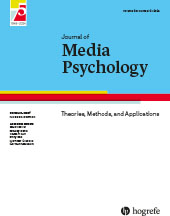Kann man dem Internet trauen, wenn es um die Gesundheit geht?
Die Glaubwürdigkeitsbeurteilung medizinischer Fachinformationen im Internet durch Laien
Abstract
Zusammenfassung. In der vorliegenden Studie geht es um die Beurteilung der Glaubwürdigkeit und Verständlichkeit medizinischer Informationen. In einem Vergleich zwischen den Medien Internet und Zeitschrift wurde an unabhängigen Stichproben experimentell überprüft, welche Wirkung das Medium auf die von Laien beurteilte Glaubwürdigkeit und Verständlichkeit der Informationen hat und ob die Bewertung zusätzlich durch die Aufbereitung der Informationen beeinflusst wird. Es zeigte sich, dass die in der Zeitschrift präsentierten Informationen unabhängig von der Gestaltung als signifikant glaubwürdiger beurteilt wurden als dieselben Informationen im Internet. Während den Informationen mit Abbildungen ebenfalls mehr Glaubwürdigkeit zugeschrieben wurde, hatte die zusätzliche Aufbereitung des im Internet dargebotenen Texts mit Hyperlinks keinen Einfluss. Bezüglich der perzipierten Verständlichkeit der Informationen ergaben sich keine Unterschiede zwischen den untersuchten Medien.
Abstract. This study investigates the effects of the medium in which medical information is presented as well as the effects of layout features of this information on perceived credibility and comprehensibility. An experiment was conducted in which laypersons had to evaluate health-related information either as a magazine article or as information from a medical web service. In addition, the layout of information was varied by using illustrations and hyperlinks. Results show that the medical information presented as a magazine article was perceived as significantly more credible than the same information presented as an online article. With regard to layout features, information with illustrations was of higher credibility than non-pictorial information, while the use of hyperlinks had no further influence. Differences between the two media regarding the comprehensibility of information were not found.
Literatur
(1998). The patient from receiver of information to informed decision-maker. Patient Education and Counseling, 34, 89– 102
(2001). Science on the web: Student evaluations of scientific arguments. Discourse Processes, 32, 191– 213
(2001). Experten-Laien-Kommunikation als Gegenstand der Expertiseforschung: Für eine Erweiterung des psychologischen Bildes vom Experten. In R. K. Silbereisen & M. Reitzle (Hrsg.), Bericht über den 42. Kongress der Deutschen Gesellschaft für Psychologie in Jena 2000 (S. 541-550). Lengerich: Pabst
(1975). Stylistic variables as related to source credibility: A content analysis approach. Speech Monographs, 42, 99– 106
(1992). Reading from paper versus screens: A critical review of the empirical literature. Ergonomics, 35, 1297– 1326
(2001, September). Über die Bedeutung von Glaubwürdigkeit und Vertrauen im Internet . Vortrag auf dem Regionaltreffen der German Internet Research List - GIR-L in Köln [On-line]. Verfügbar unter: www.allg-psych.uni-koeln.de/dzeyk/home/docs/girl_27_09_01.ppt [20. 3. 2003]
(1974). Comprehensibility of persuasive arguments as a determinant of opinion change. Journal of Personality and Social Psychology, 29, 758– 773
(1999). Patients looking for information on the Internet and seeking teleadvice. Archives of Dermatology, 135, 151– 156
(2002). How do consumers search for and appraise health information on the World Wide Web? Qualitative study using focus groups, usability tests, and in-depth interviews. British Medical Journal, 324, 573– 577
(2002). Empirical studies assessing the quality of health information for consumers on the World Wide Web - A systematic review. Journal of the American Medical Association, 287(20), 2691– 2700
(2000). Additional quality factors for the World Wide Web. Proceedings of the Second World Congress for Software Quality, Yokohama, Japan . Tokyo: Union of Japanese Scientists and Engineers (JUSE) [On-line]. Available: www.comp.dit.ie/rfitzpatrick/papers/2RF_AQF_WWW.pdf [20.10.2003]
(2000). Perceptions of Internet information credibility. Journalism and Mass Communication Quarterly, 77(3), 515– 540
(2002). How do people evaluate a web-site’s credibility? Results from a large study (Consumer WebWatch research report) . Stanford, CA: Stanford University
(1986). Measuring the concept of credibility. Journalism Quarterly, 63, 451– 462
(1982). Leserpsychologie: Textverständnis - Textverständlichkeit . Münster: Aschendorff
(1997). HON code of conduct for medical and health web sites [On-line]. Available: www.hon.ch/HONcode/Conduct.html [20. 3. 2003]
(2001). Was verstehen Laien? Die Verständlichkeit von Fachtexten aus der Sicht von Computer-Experten . Münster: Waxmann
(1990). Glaubwürdigkeit. Untersuchungen zu einem psychologischen Konstrukt . München: Psychologie Verlags Union
(1993). Sich verständlich ausdrücken . München: Ernst Reinhardt
(1982). Effects of text illustrations: A review of research. Educational Communication and Technology Journal, 30, 195– 232
(2003). Persuasion online or on paper: A new take on an old issue. Learning and Instruction, 13(5), 511– 532
(1999). Glaubwürdigkeit als Faktor im Prozess medialer Kommunikation. In P. Rössler & W. Wirth (Hrsg.), Glaubwürdigkeit im Internet: Fragestellungen, Modelle, empirische Befunde (S. 15-32). München: R. Fischer
(1999). Questionnaire survey of California consumers’ use and rating of sources of health care information including the Internet. Western Journal of Medicine, 171, 302– 306
(2001). Massenkommunikation 2000: Images und Funktionen der Massenmedien im Vergleich. Media Perspektiven, o. Jg. 3 102– 125
(1998). Wer glaubt dem World Wide Web? Ein Experiment zur Glaubwürdigkeit von Nachrichten in Tageszeitungen und im World Wide Web. In P. Rössler (Hrsg.), Online-Kommunikation. Beiträge zur Nutzung und Wirkung (S. 123-145). Opladen: Westdeutscher Verlag
(1996). Credibility. In M. Salwen & D. Stacks (Eds.), An integrated approach to communication theory and research (pp. 421-441). Mahwah, NJ: Lawrence Erlbaum
(1976). Components of credibility of a favourable news source. Journalism Quarterly, 53, 316– 319
(1994). Informierende Bilder. In B. Weidenmann (Hrsg.), Wissenserwerb mit Bildern. Instruktionale Bilder in Printmedien, Film/Video und Computerprogrammen (S. 9-58). Bern: Huber
(1999). Methodologische und konzeptionelle Aspekte der Glaubwürdigkeitsforschung. In P. Rössler & W. Wirth (Hrsg.), Glaubwürdigkeit im Internet: Fragestellungen, Modelle, empirische Befunde (S. 47-68). München: R. Fischer
(1999). Selektion neu betrachtet: Auswahlentscheidungen im Internet. In L. Dies (Hrsg.), Selektion im Internet. Empirische Analysen zu einem Schlüsselkonzept (S. 43-74). Opladen: Westdeutscher Verlag



